Deformation Behavior of S32750 Duplex Stainless Steel Based on In Situ EBSD Technology
Abstract
1. Introduction
2. Materials and Methods
3. Results
3.1. Surface Morphology Evolution
3.2. Tensile Fracture Morphology
3.3. Variation in Two-Phase Microhardness
4. Discussion
4.1. Evolution of Two-Phase Microscopic Strain
4.2. Orientation Distribution of the Two Phases
5. Conclusions
- Two-phase microhardness results: The microhardness measurements indicate that during deformation, the ferrite phase softens initially, followed by an increase in the hardness of the austenite phase, which eventually surpasses that of ferrite. Near the fracture, within a range of 1–3 mm, the hardness of both phases exhibits a wave-like pattern, suggesting that the deformation coordination between ferrite and austenite occurs through fluctuations in this region. As the distance to the fracture decreases to less than 1 mm, the hardness of both phases increases progressively, with the maximum hardness difference observed near the fracture.
- The kernel average misorientation (KAM) value for ferrite is higher than that for austenite during the first four stages of deformation; however, this trend reverses in the fifth stage, with the KAM value for austenite surpassing that for ferrite. In the fourth and fifth stages, the small-angle grain boundaries in ferrite grow rapidly, while those in austenite increase at a relatively slower rate. In the later stages of deformation, ferrite undergoes deformation through the rapid formation of a large number of low-angle grain boundaries.
- The changes in the orientation distribution density across the three crystal faces for the two phases reveal that ferrite grains exhibit a deflection during the deformation process, whereas austenite grains remain relatively stable. This differential behavior results in continuous straining of the austenite and the accumulation of deformation on the ferrite side of the two-phase boundary. Consequently, this localized deformation leads to the eventual fracture of the material.
Author Contributions
Funding
Data Availability Statement
Acknowledgments
Conflicts of Interest
References
- Li, J.; Shen, W.; Lin, P.; Wang, F.; Yang, Z. Effect of Solution Treatment Temperature on Microstructural Evolution, Precipitation Behavior, and Comprehensive Properties in UNS S32750 Super Duplex Stainless Steel. Metals 2020, 10, 1481. [Google Scholar] [CrossRef]
- Han, Y.; Zhang, Y.; Jing, H.; Gao, Z.; Xu, L.; Zhang, Z.; Zhao, L. Microstructure and Corrosion Studies on Different Zones of Super Duplex Stainless Steel UNS S32750 Weldment. Front. Mater. 2020, 7, 251. [Google Scholar] [CrossRef]
- Gennari, C.; Pezzato, L.; Tarabotti, G.; Zambon, A.; Di Schino, A.; Calliari, I. Influence of Electropulsing Treatments on Mechanical Properties of UNS S32750 Duplex Stainless Steel. Materials 2020, 13, 1613. [Google Scholar] [CrossRef] [PubMed]
- Kangas, P.; Chai, G.C. Use of Advanced Austenitic and Duplex Stainless Steels for Applications in Oil & Gas and Process Industry. Adv. Mater. Res. 2013, 794, 645–669. [Google Scholar]
- Zhang, X.; Yang, C.; Zhu, H.; Xiong, Z.; Cheng, X. Research on deformation behaviors at different temperatures of lean duplex stainless steel S32101 produced by direct cold rolling process. J. Mater. Res. Technol. 2024, 31, 2900–2914. [Google Scholar] [CrossRef]
- Dandekar, T.R.; Kumar, A.; Khatirkar, R.K.; Kumar, D.; Suwas, S. Effect of microstructure and texture on the evolution of mechanical properties in a cold rolled and annealed UNS S32101 lean duplex stainless steel sheet. Mater. Chem. Phys. 2023, 299, 127485. [Google Scholar] [CrossRef]
- Sasaki, S.; Brüggemann, H.; Katsumura, T.; Hirt, G. Hot deformation behavior and microstructure evolution of each single phase in DSS. J. Mater. Process. Technol. 2023, 322, 118195. [Google Scholar] [CrossRef]
- Fu, H.; Dönges, B.; Krupp, U.; Pietsch, U.; Fritzen, C.-P.; Yun, X.; Christ, H.-J. Microcrack initiation mechanism of a duplex stainless steel under very high cycle fatigue loading condition: The significance of load partitioning and micro residual stresses. Acta Mater. 2020, 199, 278–287. [Google Scholar] [CrossRef]
- Zhang, J.; Zhu, Y.; Xi, X.; Xiao, Z. Altered microstructure characteristics and enhanced corrosion resistance of UNS S32750 duplex stainless steel via ultrasonic surface rolling process. J. Mater. Process. Technol. 2022, 309, 117750. [Google Scholar] [CrossRef]
- Angelescu, M.L.; Cojocaru, E.M.; Șerban, N.; Cojocaru, V.D. Evaluation of hot deformation behaviour of UNS S32750 Super Duplex Stainless Steel (SDSS) alloy. Metals 2020, 10, 673. [Google Scholar] [CrossRef]
- Zhao, X.; Liu, C.; Li, Y. Hot working diagram of Super Duplex Stainless Steel UNS S32750. Hot Work. Technol. 2015, 44, 3. [Google Scholar]
- Wu, M.; Hao, W.; Li, J.; Pei, H. Study on dynamic softening Behavior of As-cast Super Duplex Stainless Steel S32750 during Thermal Deformation. Tisco Sci. Technol. 2013, 3, 32–39. [Google Scholar]
- Chai, G.; Peng, R.L.; Johansson, S. Fatigue Behaviors in Duplex Stainless Steel Studied Using In-Situ SEM-EBSD Method. Procedia Mater. Sci. 2014, 3, 1748–1753. [Google Scholar] [CrossRef]
- Zhang, Z.; Li, K.; Cai, T.; Li, P.; Zhang, Z.; Liu, R.; Yang, J.; Zhang, P. Effects of stacking fault energy on the deformation mechanisms and mechanical properties of face-centered cubic metals. Acta Met. Sin 2023, 59, 467–477. [Google Scholar]
- Du, C.; Maresca, F.; Geers, M.; Hoefnagels, J. Ferrite slip system activation investigated by uniaxial micro-tensile tests and simulations. Acta Mater. 2018, 146, 314–327. [Google Scholar] [CrossRef]
- Liang, L.W.; Wang, Y.J.; Chen, Y.; Wang, H.Y.; Dai, L.H. Dislocation nucleation and evolution at the ferrite-cementite interface under cyclic loadings. Acta Mater. 2020, 186, 267–277. [Google Scholar] [CrossRef]
- Rosado-Carrasco, J.; Krupp, U.; López-Morelos, V.; Giertler, A.; García-Rentería, M.; González-Sánchez, J. Effect of a magnetic field applied during fusion welding on the fatigue damage of 2205 duplex stainless steel joints. Int. J. Fatigue 2019, 121, 243–251. [Google Scholar] [CrossRef]
- Alvarez-Armas, I.; Knobbe, H.; Marinelli, M.; Balbi, M.; Hereñú, S.; Krupp, U. Experimental characterization of short fatigue crack kinetics in an austeno-ferritic duplex steel. Procedia Eng. 2011, 10, 1491–1496. [Google Scholar] [CrossRef][Green Version]
- Choi, J.; Ji, J.; Hwang, S.; Park, K. TRIP aided deformation of a near-Ni-free, Mn–N bearing duplex stainless steel. Mater. Sci. Eng. A 2012, 535, 32–39. [Google Scholar] [CrossRef]
- Nagoshi, T.; Kozu, S.; Inoue, Y.; O’Rourke, B.E.; Harada, Y. Fatigue damage assessment of SUS316L using EBSD and PALS measurements. Mater. Charact. 2019, 154, 61–66. [Google Scholar] [CrossRef]
- Banerjee, A.; Prusty, B.G. Fatigue and fracture behaviour of austenitic-martensitic high carbon steel under high cycle fatigue: An experimental investigation. Mater. Sci. Eng. A 2019, 749, 79–88. [Google Scholar] [CrossRef]
- Wang, W.; Wang, J.; Wang, Q.; Huang, X.; Lu, G.; Liu, Y.; Liu, C. Ferrite-austenite synergistic deformation behavior in a 2205 duplex stainless steel containing equiaxed austenite domains. Mater. Charact. 2023, 205, 113363. [Google Scholar] [CrossRef]
- Dönges, B.; Fritzen, C.P.; Christ, H.-J. Fatigue mechanism and its modeling of an austenitic-ferritic duplex stainless steel under HCF and VHCF loading conditions. In Fatigue of Materials at Very High Numbers of Loading Cycles; Springer Fachmedien Wiesbaden: Wiesbaden, Germany, 2018. [Google Scholar]
- Zhang, W.; Song, M.; Jiang, W.; Sun, G.; Shan, G.; Chen, M.; Bai, Y. Fatigue failure mechanism of 2205 duplex stainless steel using the neutron diffraction and EBSD technologies. Int. J. Fatigue 2022, 159, 106828. [Google Scholar] [CrossRef]

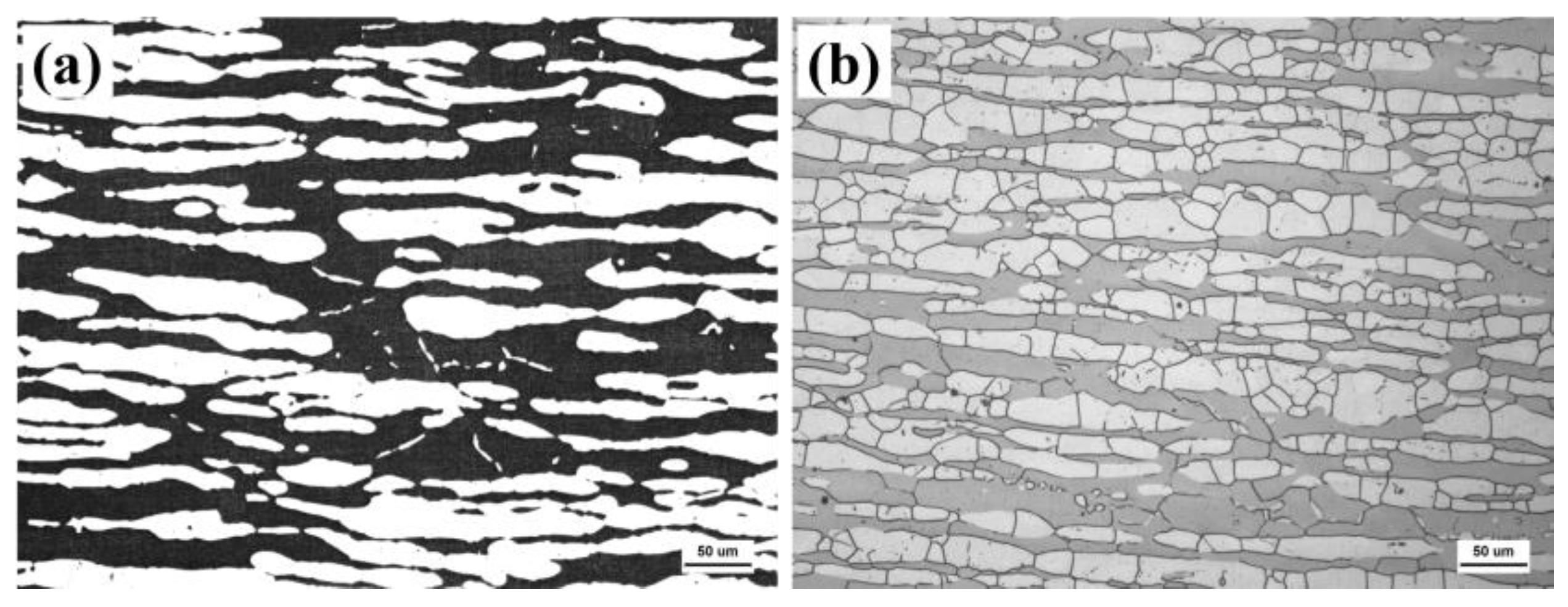
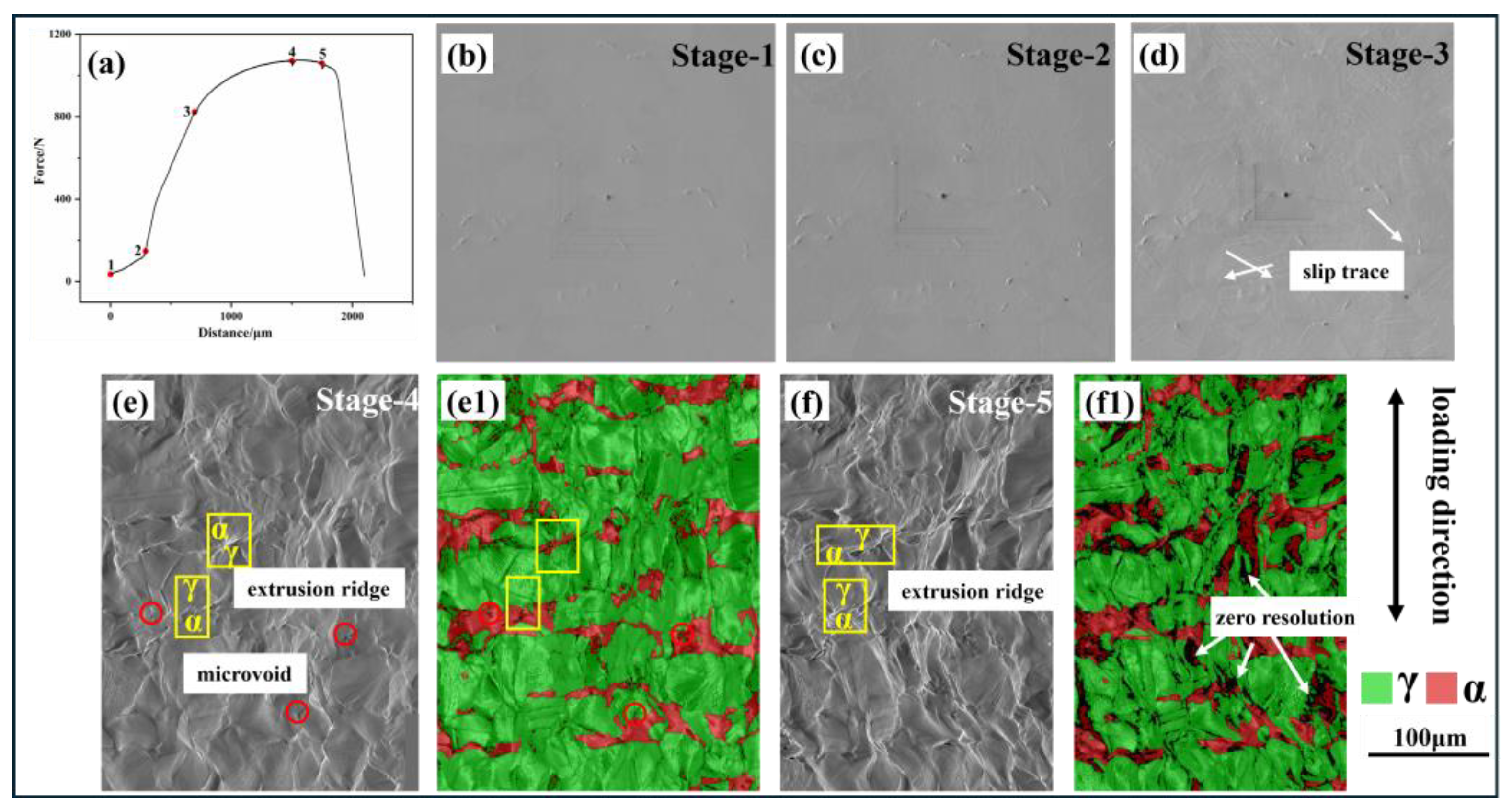

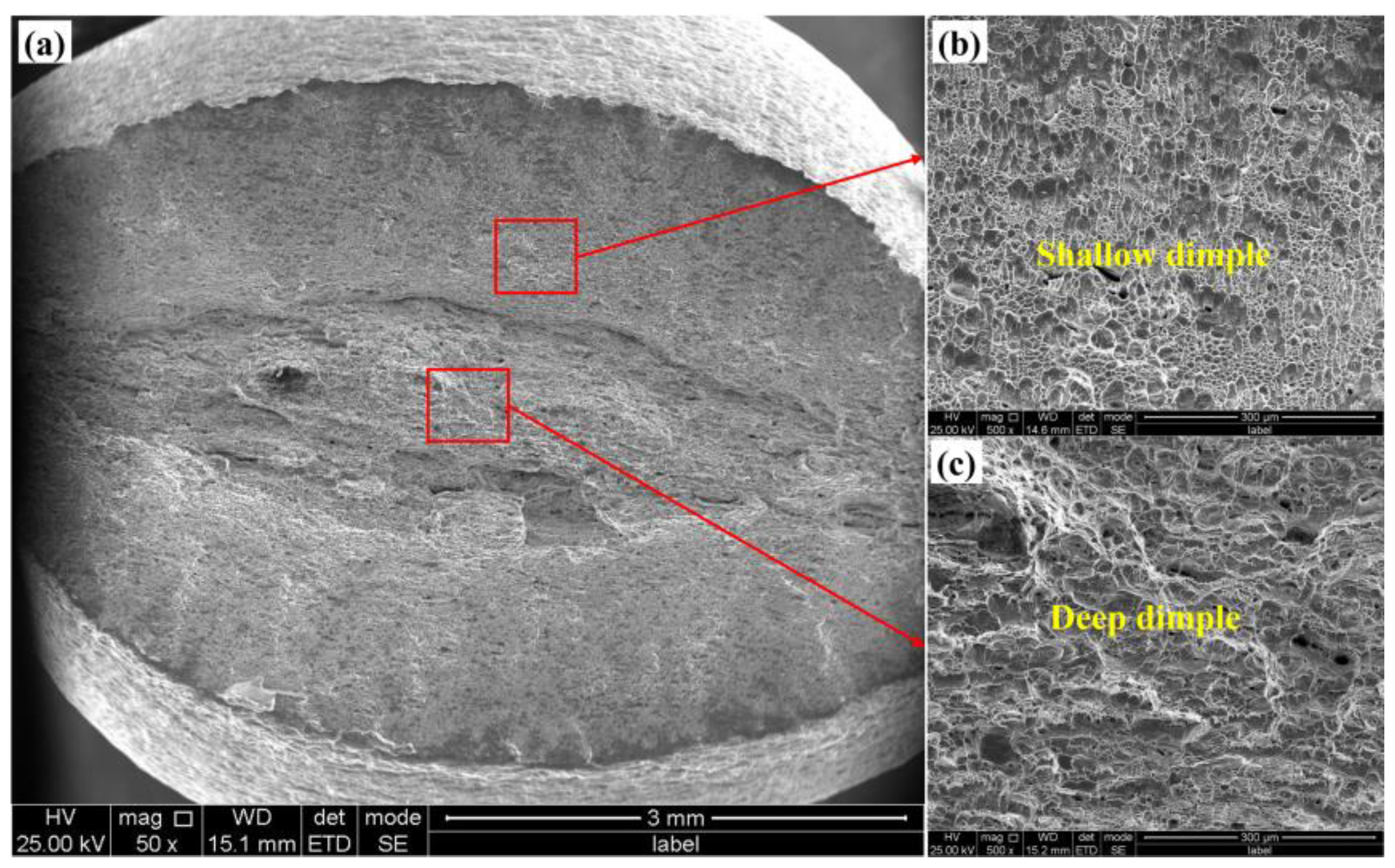
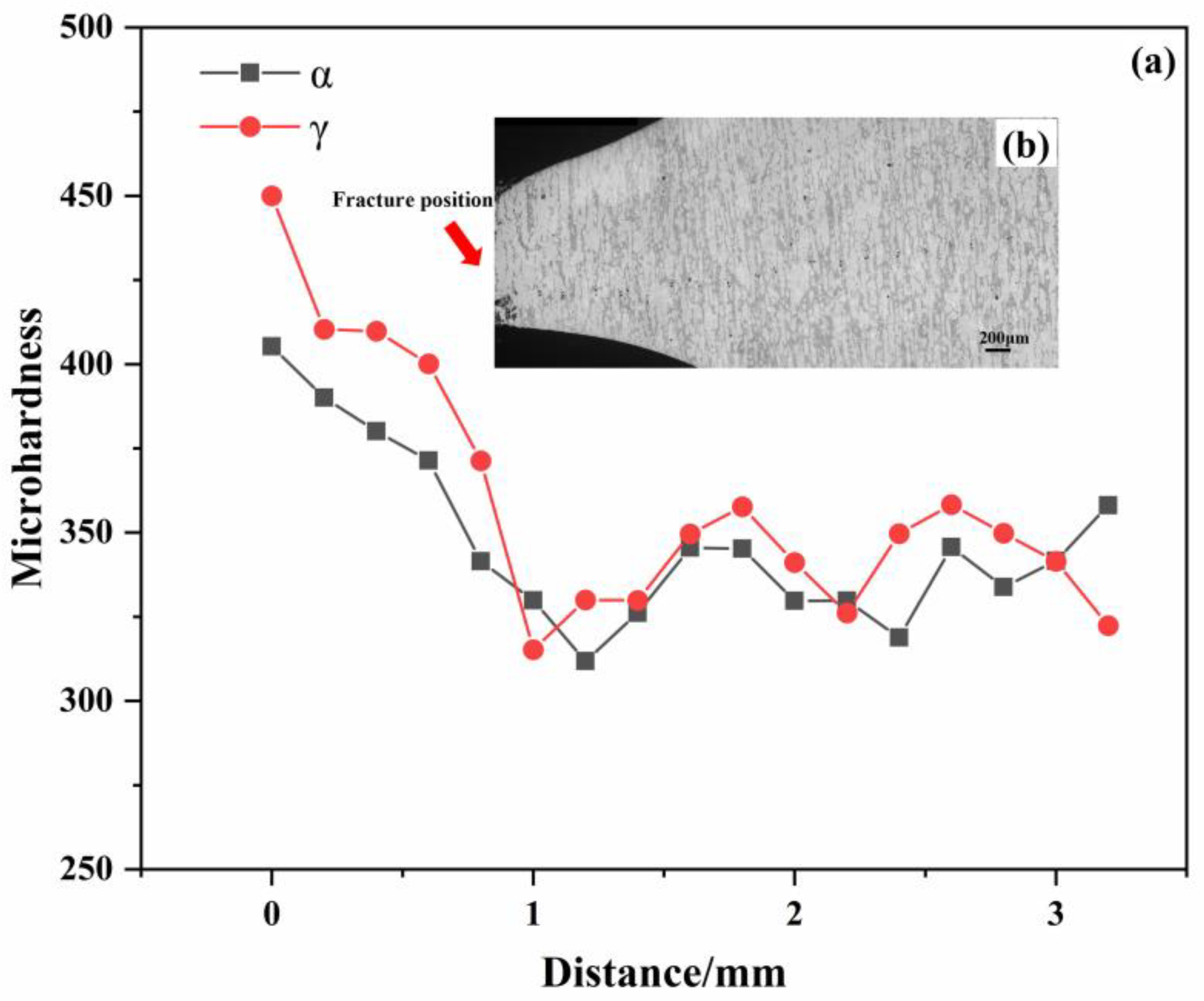
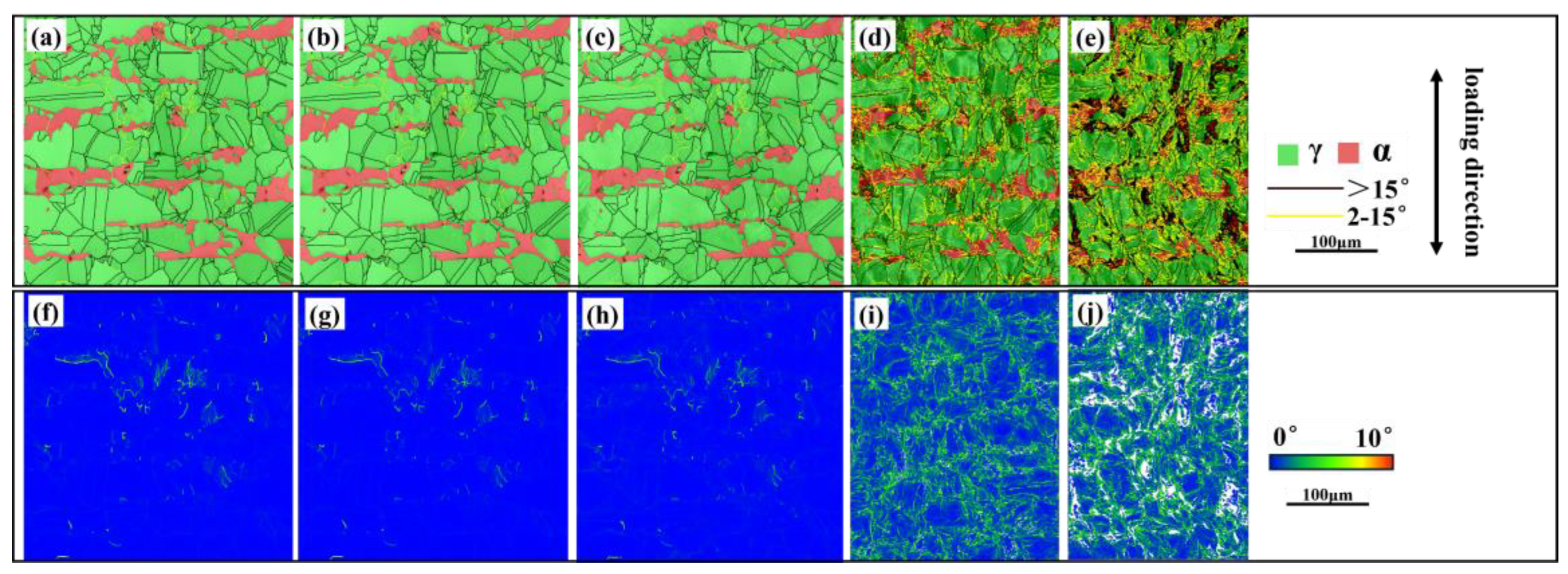

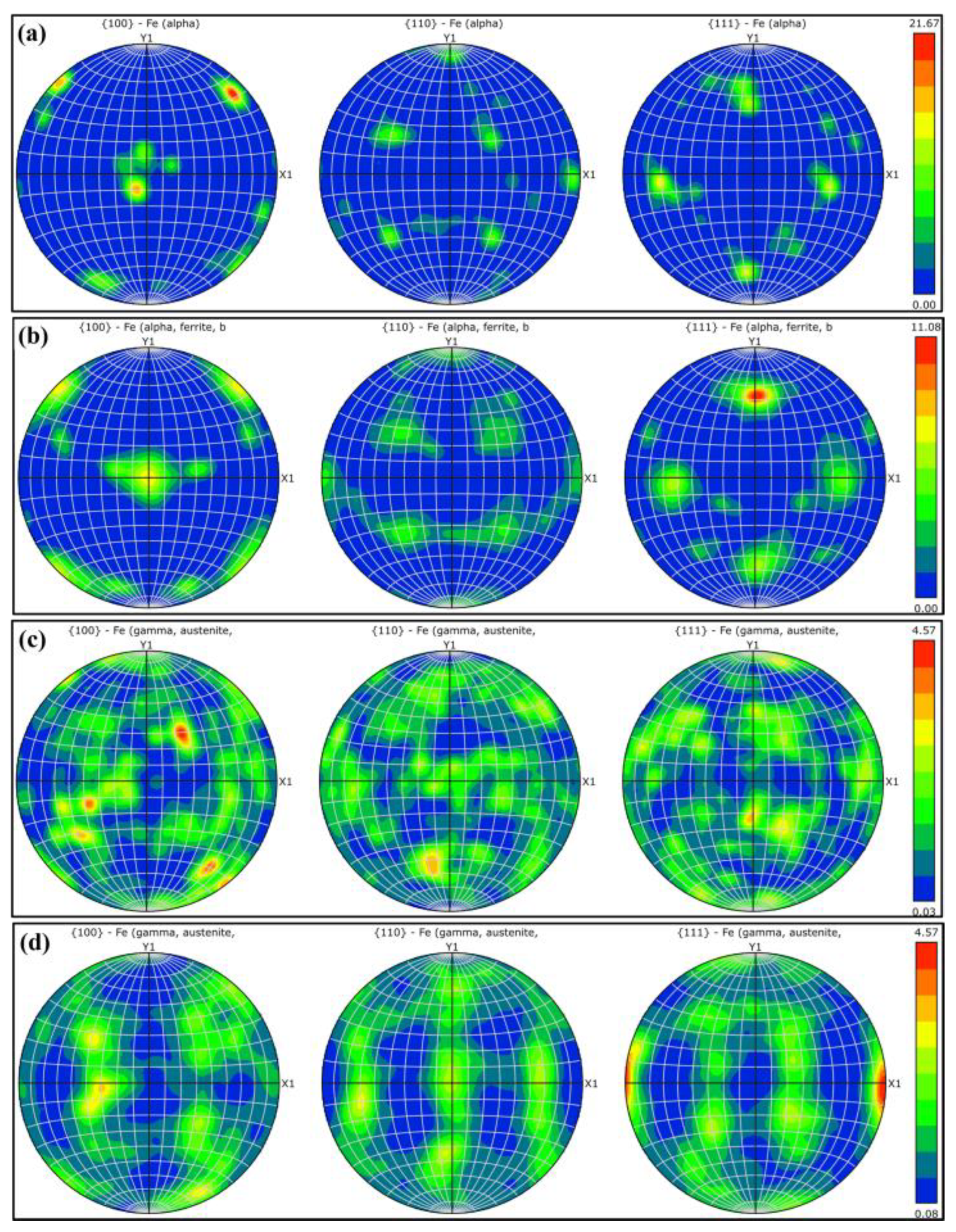
Disclaimer/Publisher’s Note: The statements, opinions and data contained in all publications are solely those of the individual author(s) and contributor(s) and not of MDPI and/or the editor(s). MDPI and/or the editor(s) disclaim responsibility for any injury to people or property resulting from any ideas, methods, instructions or products referred to in the content. |
© 2025 by the authors. Licensee MDPI, Basel, Switzerland. This article is an open access article distributed under the terms and conditions of the Creative Commons Attribution (CC BY) license (https://creativecommons.org/licenses/by/4.0/).
Share and Cite
Bao, S.; Feng, H.; Song, Z.; He, J.; Wu, X.; Gu, Y. Deformation Behavior of S32750 Duplex Stainless Steel Based on In Situ EBSD Technology. Materials 2025, 18, 2030. https://doi.org/10.3390/ma18092030
Bao S, Feng H, Song Z, He J, Wu X, Gu Y. Deformation Behavior of S32750 Duplex Stainless Steel Based on In Situ EBSD Technology. Materials. 2025; 18(9):2030. https://doi.org/10.3390/ma18092030
Chicago/Turabian StyleBao, Shun, Han Feng, Zhigang Song, Jianguo He, Xiaohan Wu, and Yang Gu. 2025. "Deformation Behavior of S32750 Duplex Stainless Steel Based on In Situ EBSD Technology" Materials 18, no. 9: 2030. https://doi.org/10.3390/ma18092030
APA StyleBao, S., Feng, H., Song, Z., He, J., Wu, X., & Gu, Y. (2025). Deformation Behavior of S32750 Duplex Stainless Steel Based on In Situ EBSD Technology. Materials, 18(9), 2030. https://doi.org/10.3390/ma18092030





